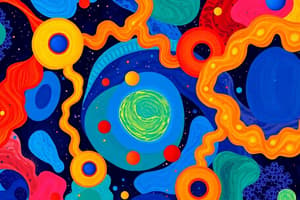Podcast
Questions and Answers
What is the primary function of hemoglobin in red blood cells?
What is the primary function of hemoglobin in red blood cells?
- To aid in cell division
- To synthesize proteins
- To regulate gene activity
- To transport oxygen (correct)
What type of mutation specifically involves a change in only one DNA base?
What type of mutation specifically involves a change in only one DNA base?
- Deletion mutation
- Frameshift mutation
- Translocation
- Point mutation (correct)
Which of the following best describes a locus?
Which of the following best describes a locus?
- The process of cell division
- The overall genetic makeup of an individual
- The alternate form of a gene
- The position of a gene on a chromosome (correct)
What is the role of transfer RNA (tRNA) during protein synthesis?
What is the role of transfer RNA (tRNA) during protein synthesis?
Which type of cell division results in the production of gametes?
Which type of cell division results in the production of gametes?
What is a codon?
What is a codon?
What is the role of regulatory genes?
What is the role of regulatory genes?
Which term describes the genetic makeup of an individual or typical of a species?
Which term describes the genetic makeup of an individual or typical of a species?
Flashcards
Nucleotide
Nucleotide
The basic building block of DNA, composed of a sugar molecule, a phosphate group, and a nitrogenous base.
DNA Base Pairing
DNA Base Pairing
Adenine pairs with Thymine, and Guanine pairs with Cytosine, crucial for DNA replication.
Gene
Gene
A segment of DNA that contains the instructions for building a specific protein.
Chromosome
Chromosome
Signup and view all the flashcards
Mutation
Mutation
Signup and view all the flashcards
Enzyme
Enzyme
Signup and view all the flashcards
Somatic Cell
Somatic Cell
Signup and view all the flashcards
Meiosis
Meiosis
Signup and view all the flashcards
Study Notes
Cell Structure and Function
- Eukaryotic cells: complex three-dimensional structures containing carbohydrates, lipids, nucleic acids, proteins, and organelles like a nucleus (containing DNA and RNA).
- Somatic cells: form body tissues.
- Gametes: involved in reproduction.
- Nucleotides: the building blocks of DNA, composed of a sugar molecule, phosphate group, and nitrogenous base.
- DNA bases: adenine (A), guanine (G), thymine (T), and cytosine (C). A pairs with T, G pairs with C during replication.
Proteins and Enzymes
- Enzymes: specialized proteins that control chemical reactions.
- Hemoglobin: a protein in red blood cells that binds oxygen.
- Hormones: substances that regulate cellular functions throughout the body.
- Amino acids: the building blocks of proteins.
RNA and Protein Synthesis
- Messenger RNA (mRNA): carries the genetic code from DNA to the ribosome.
- Codons: three-base sequences on mRNA that code for specific amino acids.
- Transfer RNA (tRNA): brings amino acids to the ribosome during protein synthesis.
DNA and Genes
- Mutation: a change in DNA sequence.
- Gene: a sequence of DNA bases that specifies the order of amino acids in a protein.
- Genome: the complete genetic makeup of an individual or species.
- Noncoding DNA: DNA that doesn't directly code for proteins.
- Exons: transcribed segments of genes involved in protein synthesis.
- Introns: transcribed segments of genes that are removed.
- Regulatory genes: control the activity of other genes.
- Homeobox genes: ancient regulatory genes controlling body plan development and segmentation.
- Sickle-cell anemia: inherited disorder causing abnormal hemoglobin and red blood cell collapse.
- Point mutation: a change in a single DNA base.
Cell Division and Reproduction
- Chromosomes: structures of DNA and proteins found in the nucleus.
- Autosomes: non-sex chromosomes.
- Sex chromosomes: X and Y chromosomes in mammals.
- Locus: the specific location of a gene on a chromosome.
- Alleles: alternate forms of a gene.
- Karyotype: a display of an individual's chromosomes.
- Mitosis: simple cell division.
- Meiosis: cell division in reproductive cells (gametes).
- Recombination: exchange of genetic material during meiosis.
- Clones: genetically identical organisms.
- Random assortment: the random distribution of chromosomes during meiosis.
Molecular Biology Techniques
- Polymerase chain reaction (PCR): a method to copy DNA segments.
Genomics
- Human Genome Project: an international effort to sequence and map the human genome.
Studying That Suits You
Use AI to generate personalized quizzes and flashcards to suit your learning preferences.




